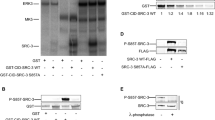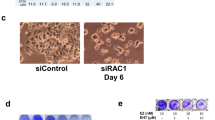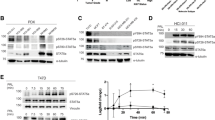Abstract
We report that in breast cancer cells, tyrosine phosphorylation of the estradiol receptor alpha (ERalpha) by Src regulates cytoplasmic localization of the receptor and DNA synthesis. Inhibition of Src or use of a peptide mimicking the ERalpha p-Tyr537 sequence abolishes ERalpha tyrosine phosphorylation and traps the receptor in nuclei of estradiol-treated MCF-7 cells. An ERalpha mutant carrying a mutation of Tyr537 to phenylalanine (ER537F) persistently localizes in nuclei of various cell types. In contrast with ERalpha wt, ER537F does not associate with Ran and its interaction with Crm1 is insensitive to estradiol. Thus, independently of estradiol, ER537F is retained in nuclei, where it entangles FKHR-driving cell cycle arrest. Chromatin immunoprecipitation analysis reveals that overexpression of ER537F in breast cancer cells enhances FKHR interaction with cyclin D1 promoter. This mutant also counteracts cell transformation by the activated forms of Src or PI3-K. In conclusion, in addition to regulating receptor localization, ERalpha phosphorylation by Src is required for hormone responsiveness of DNA synthesis in breast cancer cells.
This is a preview of subscription content, access via your institution
Access options
Subscribe to this journal
Receive 50 print issues and online access
$259.00 per year
only $5.18 per issue
Buy this article
- Purchase on Springer Link
- Instant access to full article PDF
Prices may be subject to local taxes which are calculated during checkout







Similar content being viewed by others
References
Levin ER . Extranuclear steroid receptors: roles in modulation of cell functions. Mol Endocrinol 2011; 25: 377–384.
Pemberton LF, Paschal BM . Mechanisms of receptor mediated nuclear import and nuclear export. Traffic 2005; 6: 187–198.
Rossi M, Colecchia D, Iavarone C, Strambi A, Piccioni F, Verrotti di Pianella A et al. Extracellular signal-regulated kinase 8 (ERK8) controls estrogen-related receptor alpha (ERR alpha) cellular localization and inhibits its transcriptional activity. J Biol Chem 2011; 286: 8507–8522.
Lombardi M, Castoria G, Migliaccio A, Barone MV, Di Stasio R, Ciociola A et al. Hormone-dependent nuclear export of estradiol receptor and DNA synthesis in breast cancer cells. J Cell Biol 2008; 182: 327–340.
Morelli C, Lanzino M, Garofalo C, Maris P, Brunelli E, Casaburi I et al. Akt2 inhibition enables the forkhead transcription factor FoxO3a to have a repressive role in estrogen receptor alpha transcriptional activity in breast cancer cells. Mol Cell Biol 2010; 30: 857–870.
Migliaccio A, Di Domenico M, Green S, de Falco A, Kajtaniak EL, Blasi F et al. Phosphorylation on tyrosine of in vitro synthesized human estrogen receptor activates its hormone binding. Mol Endocrinol 1989; 3: 1061–1069.
Castoria G, Migliaccio A, Green S, Di Domenico M, Chambon P, Auricchio F . Properties of a purified estradiol-dependent calf uterus tyrosine kinase. Biochemistry 1993; 32: 1740–1750.
Arnold SF, Obourn JD, Jaffe H, Notides AC . Phosphorylation of the human estrogen receptor on tyrosine 537 in vivo and by Src family tyrosine kinases in vitro. Mol Endocrinol 1995; 9: 24–33.
Arnold SF, Vorojeikina DP, Notides AC . Phosphorylation of tyrosine 537 on the human estrogen receptor is required for binding to an estrogen response element. J Biol Chem 1995; 270: 30205–30212.
Arnold SF, Bergeron JM, Tran DQ, Collins BM, Vonier PM, Crews D et al. Synergistic responses of steroidal estrogens in vitro (yeast) and in vivo (turtles). Biochem Biophys Res Commun 1997; 235: 336–342.
Migliaccio A, Piccolo D, Castoria G, Di Domenico M, Bilancio A, Lombardi M et al. Activation of the Src/p21ras/Erk pathway by progesterone receptor via cross-talk with estrogen receptor. EMBO J 1998; 17: 2008–2018.
Haendeler J, Hoffmann J, Brandes RP, Zeiher AM, Dimmeler S . Hydrogen peroxide triggers nuclear export of telomerase reverse transcriptase via Src kinase family-dependent phosphorylation of tyrosine 707. Mol Cell Biol 2003; 23: 4598–4610.
Kaspar JW, Jaiswal AK . Antioxidant-induced phosphorylation of tyrosine 486 leads to rapid nuclear export of Bach1 that allows Nrf2 to bind to the antioxidant response element and activate defensive gene expression. J Biol Chem 2010; 285: 153–162.
Migliaccio A, Castoria G, Di Domenico M, de Falco A, Bilancio A, Lombardi M et al. Steroid-induced androgen receptor-oestradiol receptor beta/Src complex triggers prostate cancer cell proliferation. EMBO J 2000; 19: 5406–5417.
Varricchio L, Migliaccio A, Castoria G, Yamaguchi H, de Falco A, Di Domenico M et al. Inhibition of estradiol receptor/Src association and cell growth by an estradiol receptor {alpha} tyrosine-phosphorylated peptide. Mol Cancer Res 2007; 11: 1213–1221.
Barone MV, Courtneidge SA . but not Fos rescue of PDGF signalling block caused by kinase-inactive Src. Nature 1995; 378: 509–512.
Castoria G, Barone MV, Di Domenico M, Bilancio A, Ametrano D, Migliaccio A et al. Non-transcriptional action of estrogen and progestin triggers DNA synthesis. EMBO J 1999; 18: 2500–2510.
Henderson BR, Eleftheriou A . A comparison of the activity, sequence specificity, and CRM1-dependence of different nuclear export signals. Exp Cell Res 2000; 256: 213–224.
Roche S, Koegl M, Barone MV, Roussel MF, Courtneidge SA . DNA synthesis induced by some but not all growth factors requires Src family protein tyrosine kinases. Mol Cell Biol 1995; 15: 1102–1109.
Pietras RJ, Arboleda J, Reese DM, Wongvipat N, Pegram MD, Ramos L et al. HER-2 tyrosine kinase pathway targets estrogen receptor and promotes hormone-independent growth in human breast cancer cells. Oncogene 1995; 10: 2435–2446.
Migliaccio A, Di Domenico M, Castoria G, Nanayakkara M, Lombardi M, de Falco A et al. Steroid receptor regulation of epidermal growth factor signaling through Src in breast and prostate cancer cells: steroid antagonist action. Cancer Res 2005; 65: 10585–10593.
He X, Zheng Z, Song T, Wei C, Ma H, Ma Q et al. c-Abl regulates estrogen receptor alpha transcription activity through its stabilization by phosphorylation. Oncogene 2010; 29: 2238–2251.
Kato S, Endoh H, Masuhiro Y, Kitamoto T, Uchiyama S, Sasaki H et al. Activation of the estrogen receptor through phosphorylation by mitogen-activated protein kinase. Science 1995; 270: 1491–1494.
Lee H, Jiang F, Wang Q, Nicosia SV, Yang J, Su B et al. MEKK1 activation of human estrogen receptor alpha and stimulation of the agonistic activity of 4-hydroxytamoxifen in endometrial and ovarian cancer cells. Mol Endocrinol 2000; 14: 1882–1896.
Campbell RA, Bhat-Nakshatri P, Patel NM, Constantinidou D, Ali S, Nakshatri H . Phosphatidylinositol 3-kinase/AKT-mediated activation of estrogen receptor alpha:a new model for anti-estrogen resistance. J Biol Chem 2001; 276: 9817–9824.
Blake RA, Broome MA, Liu X, Wu J, Gishizky M, Sun L et al. SU6656, a selective Src family kinase inhibitor, used to probe growth factor signaling. Mol Cell Biol 2000; 20: 9018–9027.
Bischoff FR, Klebe C, Kretschemer J, Wiittinghofer A, Ponstingl H . RanGAP1 induces GTPase activity of nuclear Ras-related Ran. Proc Natl Acad Sci USA 1994; 91: 2587–2591.
Rodriguez-Viciana P, Warne PH, Khwaja A, Marte BM, Pappin D, Das P et al. Role of phosphoinositide 3-OH kinase in cell transformation and control of the actin cytoskeleton byRas. Cell 1997; 89: 457–467.
Cowley S, Paterson H, Kemp P, Marshall CJ . Activation of MAP kinase kinase is necessary and sufficient for PC12 differentiation and for transformation of NIH 3T3 cells. Cell 1994; 77: 841–852.
Schmidt M, Fernandez de Mattos S, van der Horst A, Klompmaker R, Kops GJ, Lam EW et al. Cell cycle inhibition by FoxOforkhead transcription factors involves downregulation of cyclin D. Mol Cell Biol 2002; 22: 7842–7852.
Cicatiello L, Addeo R, Sasso A, Altucci L, Petrizzi VB, Borgo R et al. Estrogens and progesterone promote persistent CCND1 gene activation during G1 by inducing transcriptional derepression via c-Jun/c-Fos/estrogen receptor (progesterone receptor) complex assembly to a distal regulatory element and recruitment of cyclin D1 to its own gene promoter. Mol Cell Biol 2004; 24: 7260–7274.
Eeckhoute J, Carroll JS, Geistlinger TR, Torres-Arzayus MI, Brown M . A cell-type-specific transcriptional network required for estrogen regulation of cyclinD1 and cell cycle progression in breast cancer. GenesDev 2006; 20: 2513–2526.
Medema RH, Kops GJ, Bos JL, Burgering BM . AFX-like Forkhead transcription factors mediate cell-cycle regulation by Ras and PKB through p27kip1. Nature 2000; 404: 782–787.
Shang Y, Hu X, DiRenzo J, Lazar MA, Brown M . Cofactor dynamics and sufficiency in estrogen receptor-regulated transcription. Cell 2000; 103: 843–852.
Castoria G, Migliaccio A, Di Domenico M, Lombardi M, de Falco A, Varricchio L et al. Role of atypical PKC in estradiol-triggered G1/S progression of MCF-7 cells. Mol Cell Biol 2004; 24: 7643–7653.
Biscardi JS, Ishizawar RC, Silva CM, Parsons SJ . Tyrosine kinase signalling in breast cancer: epidermal growth factor receptor and c-Src interactions in breast cancer. Breast Cancer Res 2000; 2: 203–210.
Kumar R, Wang RA, Mazumdar A, Talukder AH, Mandal M, Yang Z et al. A naturally occurring MTA1 variant sequesters oestrogen receptor-alpha in the cytoplasm. Nature 2002; 418: 654–657.
Erenburg I, Schachter B, Mira y Lopez R, Ossowski L . Loss of an estrogen receptor isoform (ER alpha delta 3) in breast cancer and the consequences of its reexpression: interference with estrogen-stimulated properties of malignant transformation. Mol Endocrinol 1997; 11: 2004–2015.
Chu I, Arnaout A, Loiseau S, Sun J, Seth A, McMahon C et al. Src promotes estrogen-dependent estrogen receptor alpha proteolysis in human breast cancer. J Clin Invest 2007; 117: 2205–2215.
White R, Sjöberg M, Kalkhoven E, Parker MG . Ligand-independent activation of the oestrogen receptor by mutation of a conserved tyrosine. EMBO J 1997; 16: 1427–1435.
Weis KE, Ekena K, Thomas JA, Lazennec G, Katzenellenbogen BS . Constitutively active human estrogen receptors containing amino acid substitutions for tyrosine 537 in the receptor protein. Mol Endocrinol 1996; 10: 1388–1398.
Lazennec G, Ediger TR, Petz LN, Nardulli AM, Katzenellenbogen BS . Mechanistic aspects of estrogen receptor activation probed with constitutively active estrogen receptors: correlations with DNA and coregulator interactions and receptor conformational changes. Mol Endocrinol 1997; 11: 1375–1386.
Auricchio F, Migliaccio A, Castoria G . Dephosphorylation of oestradiolnuclearreceptor in vitro. A hypothesis on the mechanism of action of non-steroidal anti-oestrogens. Biochem J 1981; 198: 699–702.
Auricchio F, Di Domenico M, Migliaccio A, Castoria G, Bilancio A . The role of estradiol receptor in the proliferative activity of vanadate on MCF-7 cells. Cell Growth Differ 1995; 6: 105–113.
Métivier R, Penot G, Hübner MR, Reid G, Brand H, Kos M et al. Estrogen receptor-alpha directs ordered, cyclical, and combinatorial recruitment of cofactors on a natural target promoter. Cell 2003; 115: 751–763.
Weinberg RA . The retinoblastoma protein and cell cycle control. Cell 1995; 81: 323–330.
Castoria G, Migliaccio A, Bilancio A, Pagano M, Abbondanza C, Auricchio F . A 67 kDa non-hormone binding estradiol receptor is present in human mammary cancers. Int J Cancer 1996; 65: 574–583.
Migliaccio A, Pagano M, De Goeij CC, Di Domenico M, Castoria G, Sluyser M et al. Phosphorylation and estradiol binding of estrogen receptor in hormone-dependent and hormone-independent GR mouse mammary tumors. Int J Cancer 1992; 51: 733–739.
Tora L, Mullick A, Metzger D, Ponglikitmongkol M, Park I, Chambon P . The cloned human oestrogen receptor contains a mutation which alters its hormone binding properties. EMBO J 1989; 8: 1981–1986.
Izaurralde E, Kutay U, von Kobbe C, Mattaj IW, Gorlich D . asymmetric distribution of the constituents of the Ran system is essential for transport into and out of the nucleus. EMBO J 1997; 16: 6535–6547.
Alt JR, Cleveland JL, Hannink M, Diehl JA . Phosphorylation dependent regulation of cyclin D1 nuclear export and cyclin D1-dependent cellular transformation. Genes Dev 2000; 14: 3102–3114.
Castoria G, Migliaccio A, Bilancio A, Di Domenico M, de Falco A, Lombardi M et al. PI3-kinase in concert with Src promotes the S-phase entry of estradiol-stimulated MCF-7 cells. EMBO J 2001; 20: 6050–6059.
Abbondanza C, De Rosa C, D’Arcangelo A, Pacifico M, Spizuoco C, Piluso G et al. Identification of a functional estrogen-responsive enhancer element in the promoter 2 of PRDM2 gene in breast cancer cell lines. J Cell Physiol (advance online publication, 18 April 2011; doi:10.1002/jcp.22803).
Castoria G, Lombardi M, Barone MV, Bilancio A, Di Domenico M, Bottero D et al. Androgen stimulated DNA synthesis and cytoskeletal changes in fibroblasts by a non transcriptional receptor action. J Cell Biol 2003; 161: 547–556.
Castoria G, D’Amato L, Ciociola A, Giovannelli P, Giraldi T, Sepe L et al. Androgen-induced cell migration: role of androgen receptor/filamina association. PLoS One 2011; 6: e17218.
Acknowledgements
This work was funded by the Italian Association for Cancer Research (A.I.R.C.; Grant No. IG 5389). PG is supported by a fellowship from A.I.R.C.
Author information
Authors and Affiliations
Corresponding author
Ethics declarations
Competing interests
The authors declare no conflict of interest.
Additional information
Supplementary Information accompanies the paper on the Oncogene website
Supplementary information
Rights and permissions
About this article
Cite this article
Castoria, G., Giovannelli, P., Lombardi, M. et al. Tyrosine phosphorylation of estradiol receptor by Src regulates its hormone-dependent nuclear export and cell cycle progression in breast cancer cells. Oncogene 31, 4868–4877 (2012). https://doi.org/10.1038/onc.2011.642
Received:
Revised:
Accepted:
Published:
Issue Date:
DOI: https://doi.org/10.1038/onc.2011.642
Keywords
This article is cited by
-
Estrogen receptor-α signaling in post-natal mammary development and breast cancers
Cellular and Molecular Life Sciences (2021)
-
Transportin-2 plays a critical role in nucleocytoplasmic shuttling of oestrogen receptor-α
Scientific Reports (2020)
-
Androgens Induce Invasiveness of Triple Negative Breast Cancer Cells Through AR/Src/PI3-K Complex Assembly
Scientific Reports (2019)
-
microRNA Regulation in Estrogen Receptor-Positive Breast Cancer and Endocrine Therapy
Biological Procedures Online (2018)
-
Role of non-genomic androgen signalling in suppressing proliferation of fibroblasts and fibrosarcoma cells
Cell Death & Disease (2014)



